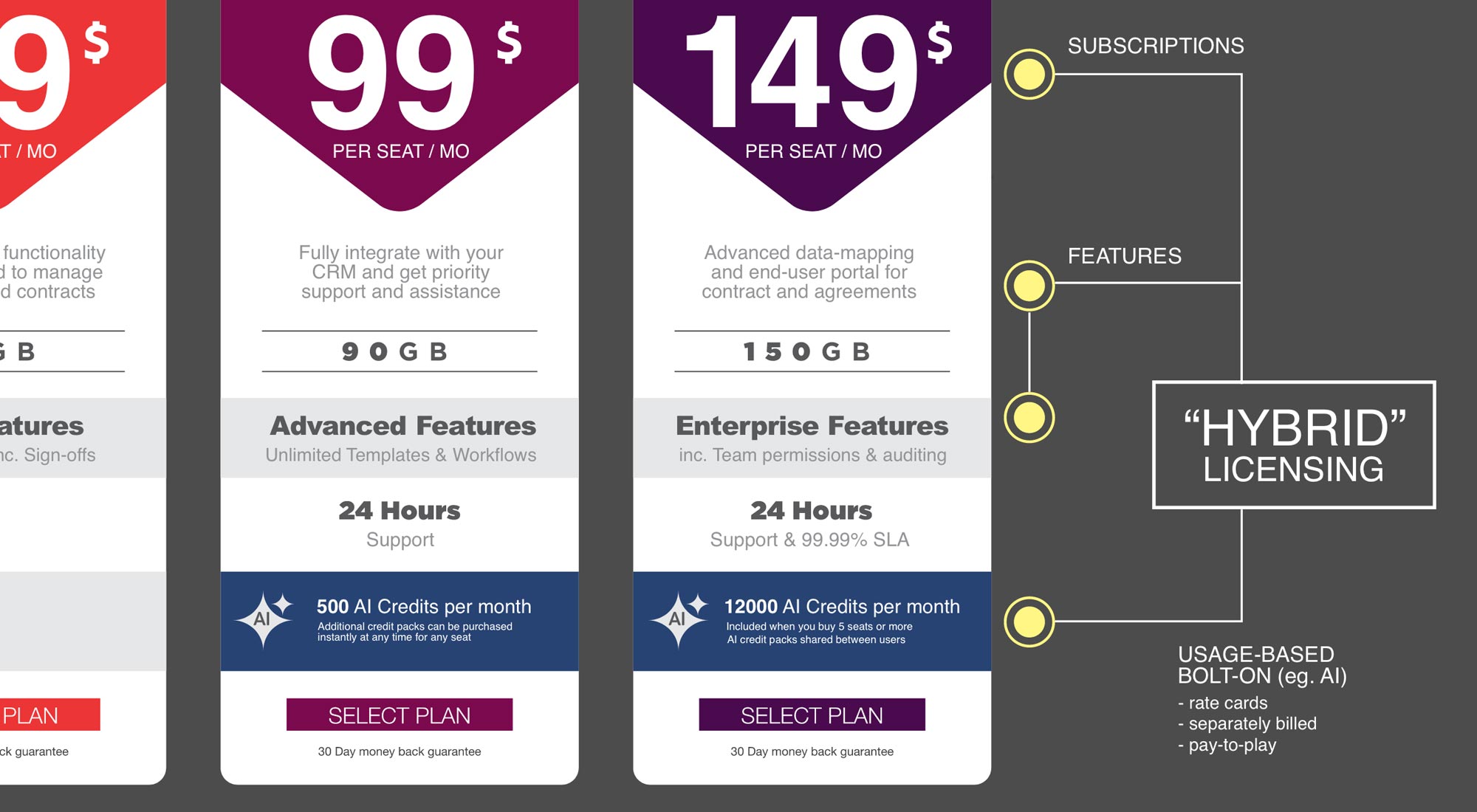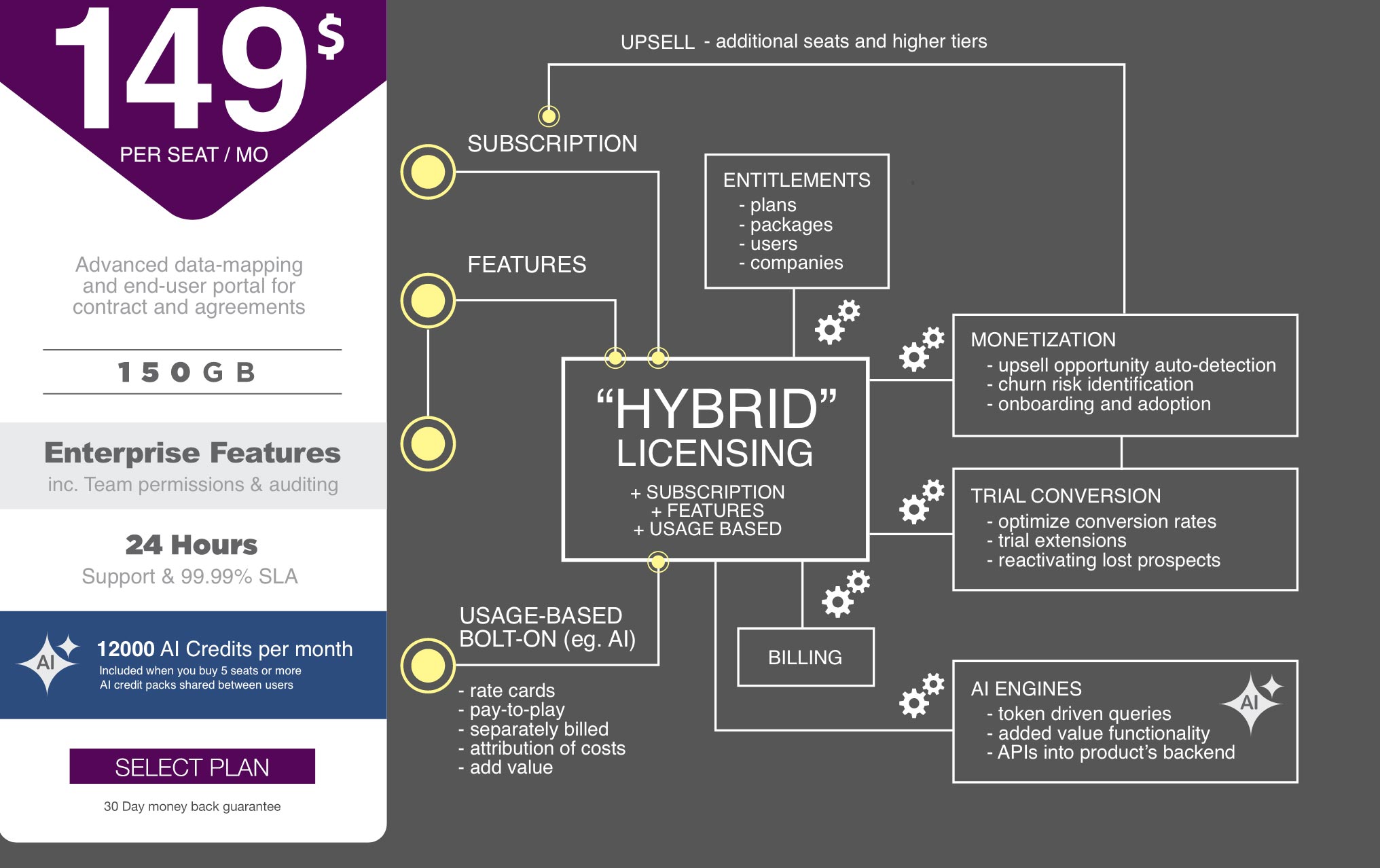5
-min read

Your software licensing strategy needs a complete overhaul. Artificial intelligence is fundamentally transforming how you price and package your products, moving beyond the limitations of traditional seat-based subscriptions to embrace dynamic, usage-driven models.
The software industry is experiencing what can only be described as a monetization revolution with the introduction of AI. What was once dominated by simple flat-rate subscriptions is rapidly evolving into a complex landscape where AI hybrid licensing models combine subscription and usage-based elements to become the new standard.
Your old pricing models are becoming obsolete faster than you think. Recent data from 240 software companies reveals a dramatic shift away from traditional approaches that no longer align with how AI solutions deliver value.
The numbers tell a compelling story across multiple pricing dimensions:
This dramatic shift reflects how companies are responding to the fundamental mismatch between traditional pricing and AI value delivery.
This transformation is particularly pronounced for AI applications, where value misalignment and cost pressures are forcing you to rethink your entire monetization strategy. The rise of AI tools and AI solutions has fundamentally altered the value equation for your customers.
When artificial intelligence works as intended, your customers require fewer personnel and more AI capabilities. This creates a profound disconnect with traditional per-seat pricing models, which charge based on the number of human users rather than the computing resources consumed.
Your AI software requires substantial computing resources that vary dramatically based on usage patterns. Traditional licensing models are unable to accommodate the dynamic nature of AI workloads, which consume different amounts of processing power depending on task complexity and user demand.
The integration of cutting-edge technology in business functions demands a more sophisticated approach to license management. Natural language processing and generative AI capabilities require flexible pricing that accurately reflects resource consumption while maintaining predictable base costs.
AI development and model development require significant investment in training data and proprietary models. Each AI model must be optimized with fewer parameters to achieve greater efficiency while maintaining high performance capabilities.
Consider how AI has transformed productivity across multiple industries and business functions:
Your pricing strategy must evolve to capture value from these AI-driven productivity gains rather than limiting revenue to traditional user-based metrics.
Hybrid AI models have emerged as the solution because they offer several compelling advantages for both you and your customers. These innovative AI solutions combine the predictability of subscription pricing with the fairness of usage-based billing through a hybrid approach.
The main benefits that make hybrid AI models so attractive include:
These advantages explain why hybrid pricing has become the fastest-growing pricing model in the software industry.

Your success with hybrid AI licensing depends on implementing robust technical architectures that can effectively monitor and manage resource usage. Modern data pipelines integrate seamlessly with cloud platforms to capture granular usage metrics across all AI applications.
You need sophisticated metering systems that can monitor everything from API calls to processing power consumption in real-time. These monitoring systems provide comprehensive insights into how different customers utilize AI features, enabling accurate cost attribution and billing while protecting sensitive data.
The technological advancements in usage tracking enable more granular control over resource allocation and pricing. Your ability to monitor AI service usage patterns helps identify opportunities for optimization while maintaining regulatory compliance and data protection standards.
Your hybrid licensing infrastructure must incorporate several critical components that work together seamlessly for informed decision making:
These elements form an interconnected asset management system that enables precise tracking, analysis, and optimization of software usage across your organization. The integration of data science and logical reasoning capabilities ensures informed decision-making throughout your operations.
Your operational costs for AI-enhanced software require sophisticated monitoring to maintain profitability. The costs of delivering AI capabilities are real and increasingly becoming a key input into pricing decisions.
Companies cite internal costs and margins as the most important factors when pricing AI capabilities. This focus on cost management makes flat-rate subscriptions particularly challenging for AI products, where gross margins can drop significantly below those of traditional SaaS models.
Traditional SaaS products typically maintain gross margins exceeding 80%. However, AI-enhanced companies report gross margins between 50% and 55% due to the computational costs of machine learning and data processing.
Your hybrid AI approach must account for several critical cost factors and provide scalability:
This comprehensive approach to cost monitoring supports both operational efficiency and long-term profitability in an increasingly AI-driven market. Modern generative AI systems require sophisticated asset management to strike a balance between performance and cost control.

As you embrace hybrid models, you'll discover seemingly infinite ways to structure pricing. The complexity ranges from simple pay-as-you-go models to sophisticated multi-tier systems tailored to your specific market needs.
The most effective hybrid pricing structures each serve different customer segments and business objectives:
Each structure serves different customer segments and use cases, allowing you to optimize pricing for maximum market penetration and revenue generation. This approach is common in modern SaaS pricing models.
While only 5% of companies currently use outcome-based pricing as their primary model, 25% expect to adopt it by 2028. This represents the "holy grail" of software pricing, where you align vendor compensation directly with customer success.
Implementing outcome-based pricing requires meeting specific criteria:
Companies pioneering this approach particularly in scenarios where AI agents perform work traditionally done by humans are seeing significant success with outcome-tied pricing models.
Your competitive edge depends heavily on implementing sophisticated hybrid AI licensing models that adapt to changing market conditions. Organizations utilizing AI-driven licensing strategies see significant improvements in customer retention compared to traditional models.
The implementation of AI-powered analytics transforms your ability to respond to market changes and customer needs. Advanced data processing capabilities enable real-time monitoring of usage patterns and customer behavior across different market segments.
Your licensing strategy benefits from comprehensive insights generated through sophisticated data pipelines and asset management systems. These intelligent systems continuously evaluate performance metrics and adjust licensing parameters to maintain optimal value delivery.
The integration of hybrid AI models significantly reduces friction in complex enterprise sales processes. Your sales teams can leverage data-driven insights to demonstrate clear value propositions based on actual usage patterns and ROI metrics.
Cloud based models enable seamless scalability and customization for enterprise clients while reducing deployment times significantly. These advanced systems support complex tasks while ensuring consistent performance and regulatory compliance across global operations.
The evolution from owning software to renting it through SaaS subscriptions to using it on-demand represents a broader trend toward risk transfer from buyers to vendors. Each stage has lowered upfront costs and made vendors more accountable for delivering customer outcomes.
As pricing becomes increasingly strategic and complex, most companies are unprepared to keep up. Three-quarters of software companies made pricing changes in the past year, but ownership often falls through organizational cracks.
The data reveals a "pricing no-man's land" between $5-20M ARR, where responsibility shifts from founders to various departments without clear ownership. At larger scales, product teams increasingly take the lead in pricing strategy and decision-making processes.
Your transition to hybrid AI licensing requires attention to several critical success factors from the previous year's learnings:
These factors will determine which companies successfully navigate the transition to AI-driven monetization models.
The shift toward hybrid AI licensing models isn't just a trend. It represents a fundamental reimagining of how software creates and captures value in an AI-driven world.
Your success depends on implementing systems that can accurately track computational resources, provide transparent usage insights, and maintain cost efficiency while delivering powerful AI capabilities. The convergence of data science, machine learning, and advanced analytics creates new opportunities for more transparent, flexible, and value-driven licensing approaches.
Organizations that embrace these intelligent AI solutions will gain significant competitive advantages, enabling them to deliver more personalized experiences, optimize revenue streams, and foster deeper customer relationships through data-driven insights and adaptive technological frameworks.
The future belongs to companies that can successfully implement hybrid AI models while maintaining operational efficiency and customer satisfaction. Your software licensing strategy must evolve to capture the full value of artificial intelligence while ensuring fair, transparent pricing that grows with your customers' success.
Ready to implement hybrid AI licensing for your software? Discover how Zentitle's flexible licensing platform can help you transition from traditional pricing models to dynamic, usage-based monetization that scales with your AI capabilities.